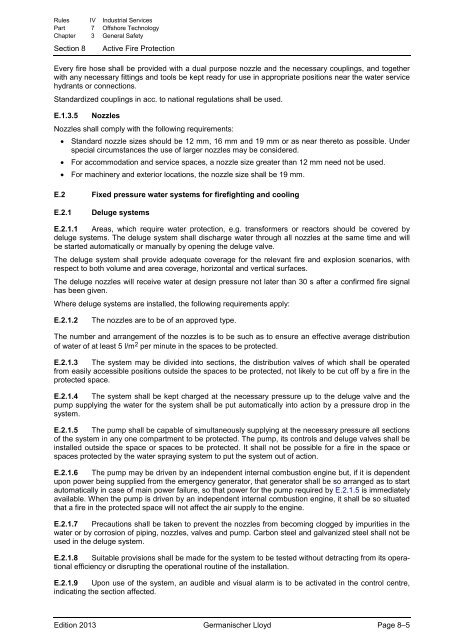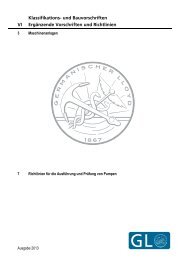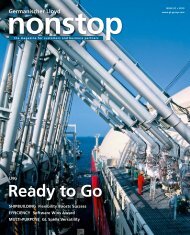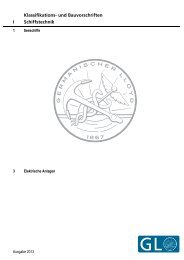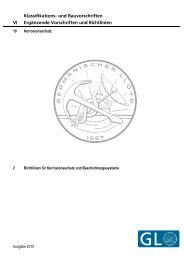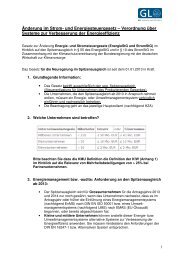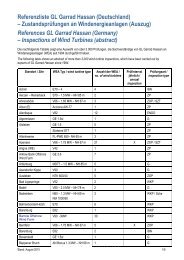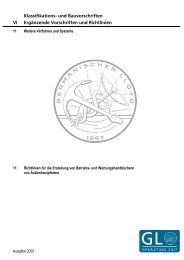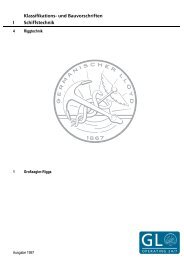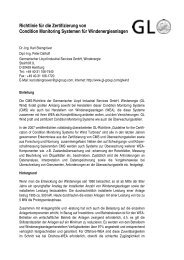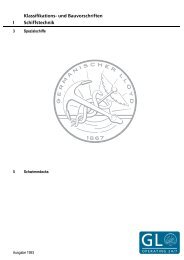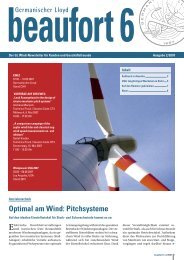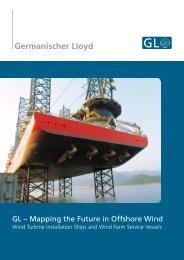(IV-7-3) General Safety
(IV-7-3) General Safety
(IV-7-3) General Safety
You also want an ePaper? Increase the reach of your titles
YUMPU automatically turns print PDFs into web optimized ePapers that Google loves.
Rules <strong>IV</strong> Industrial Services<br />
Part 7 Offshore Technology<br />
Chapter 3 <strong>General</strong> <strong>Safety</strong><br />
Section 8<br />
Active Fire Protection<br />
Every fire hose shall be provided with a dual purpose nozzle and the necessary couplings, and together<br />
with any necessary fittings and tools be kept ready for use in appropriate positions near the water service<br />
hydrants or connections.<br />
Standardized couplings in acc. to national regulations shall be used.<br />
E.1.3.5 Nozzles<br />
Nozzles shall comply with the following requirements:<br />
• Standard nozzle sizes should be 12 mm, 16 mm and 19 mm or as near thereto as possible. Under<br />
special circumstances the use of larger nozzles may be considered.<br />
• For accommodation and service spaces, a nozzle size greater than 12 mm need not be used.<br />
• For machinery and exterior locations, the nozzle size shall be 19 mm.<br />
E.2 Fixed pressure water systems for firefighting and cooling<br />
E.2.1<br />
Deluge systems<br />
E.2.1.1 Areas, which require water protection, e.g. transformers or reactors should be covered by<br />
deluge systems. The deluge system shall discharge water through all nozzles at the same time and will<br />
be started automatically or manually by opening the deluge valve.<br />
The deluge system shall provide adequate coverage for the relevant fire and explosion scenarios, with<br />
respect to both volume and area coverage, horizontal and vertical surfaces.<br />
The deluge nozzles will receive water at design pressure not later than 30 s after a confirmed fire signal<br />
has been given.<br />
Where deluge systems are installed, the following requirements apply:<br />
E.2.1.2<br />
The nozzles are to be of an approved type.<br />
The number and arrangement of the nozzles is to be such as to ensure an effective average distribution<br />
of water of at least 5 l/m 2 per minute in the spaces to be protected.<br />
E.2.1.3 The system may be divided into sections, the distribution valves of which shall be operated<br />
from easily accessible positions outside the spaces to be protected, not likely to be cut off by a fire in the<br />
protected space.<br />
E.2.1.4 The system shall be kept charged at the necessary pressure up to the deluge valve and the<br />
pump supplying the water for the system shall be put automatically into action by a pressure drop in the<br />
system.<br />
E.2.1.5 The pump shall be capable of simultaneously supplying at the necessary pressure all sections<br />
of the system in any one compartment to be protected. The pump, its controls and deluge valves shall be<br />
installed outside the space or spaces to be protected. It shall not be possible for a fire in the space or<br />
spaces protected by the water spraying system to put the system out of action.<br />
E.2.1.6 The pump may be driven by an independent internal combustion engine but, if it is dependent<br />
upon power being supplied from the emergency generator, that generator shall be so arranged as to start<br />
automatically in case of main power failure, so that power for the pump required by E.2.1.5 is immediately<br />
available. When the pump is driven by an independent internal combustion engine, it shall be so situated<br />
that a fire in the protected space will not affect the air supply to the engine.<br />
E.2.1.7 Precautions shall be taken to prevent the nozzles from becoming clogged by impurities in the<br />
water or by corrosion of piping, nozzles, valves and pump. Carbon steel and galvanized steel shall not be<br />
used in the deluge system.<br />
E.2.1.8 Suitable provisions shall be made for the system to be tested without detracting from its operational<br />
efficiency or disrupting the operational routine of the installation.<br />
E.2.1.9 Upon use of the system, an audible and visual alarm is to be activated in the control centre,<br />
indicating the section affected.<br />
Edition 2013 Germanischer Lloyd Page 8–5


